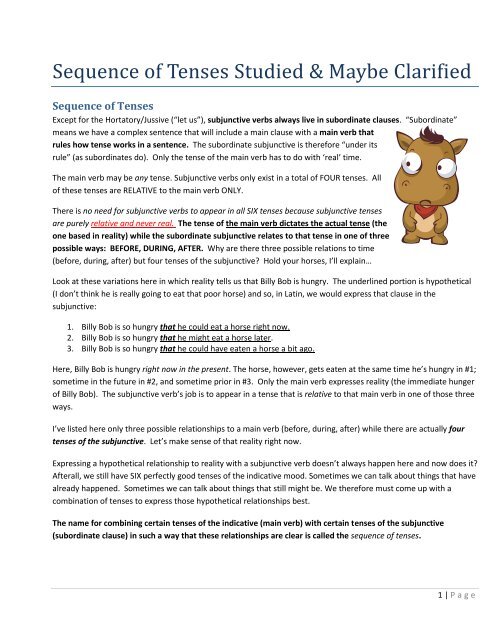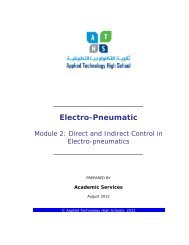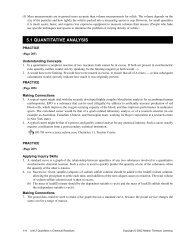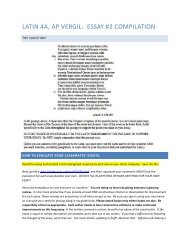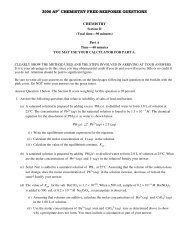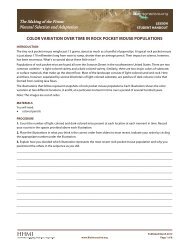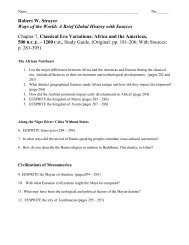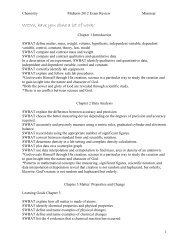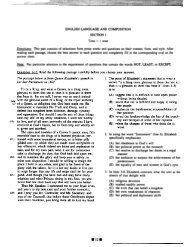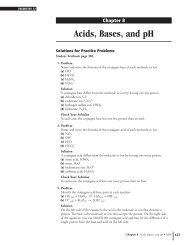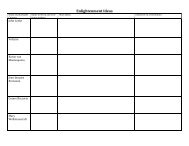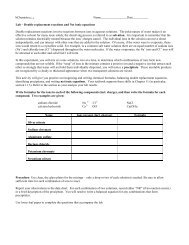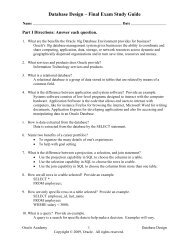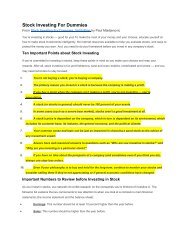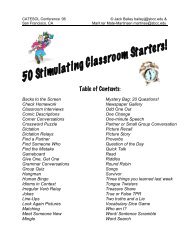Sequence of Tenses Studied & Maybe Clarified - Quia
Sequence of Tenses Studied & Maybe Clarified - Quia
Sequence of Tenses Studied & Maybe Clarified - Quia
Create successful ePaper yourself
Turn your PDF publications into a flip-book with our unique Google optimized e-Paper software.
<strong>Sequence</strong> <strong>of</strong> <strong>Tenses</strong> <strong>Studied</strong> & <strong>Maybe</strong> <strong>Clarified</strong><br />
<strong>Sequence</strong> <strong>of</strong> <strong>Tenses</strong><br />
Except for the Hortatory/Jussive (“let us”), subjunctive verbs always live in subordinate clauses. “Subordinate”<br />
means we have a complex sentence that will include a main clause with a main verb that<br />
rules how tense works in a sentence. The subordinate subjunctive is therefore “under its<br />
rule” (as subordinates do). Only the tense <strong>of</strong> the main verb has to do with ‘real’ time.<br />
The main verb may be any tense. Subjunctive verbs only exist in a total <strong>of</strong> FOUR tenses. All<br />
<strong>of</strong> these tenses are RELATIVE to the main verb ONLY.<br />
There is no need for subjunctive verbs to appear in all SIX tenses because subjunctive tenses<br />
are purely relative and never real. The tense <strong>of</strong> the main verb dictates the actual tense (the<br />
one based in reality) while the subordinate subjunctive relates to that tense in one <strong>of</strong> three<br />
possible ways: BEFORE, DURING, AFTER. Why are there three possible relations to time<br />
(before, during, after) but four tenses <strong>of</strong> the subjunctive? Hold your horses, I’ll explain…<br />
Look at these variations here in which reality tells us that Billy Bob is hungry. The underlined portion is hypothetical<br />
(I don’t think he is really going to eat that poor horse) and so, in Latin, we would express that clause in the<br />
subjunctive:<br />
1. Billy Bob is so hungry that he could eat a horse right now.<br />
2. Billy Bob is so hungry that he might eat a horse later.<br />
3. Billy Bob is so hungry that he could have eaten a horse a bit ago.<br />
Here, Billy Bob is hungry right now in the present. The horse, however, gets eaten at the same time he’s hungry in #1;<br />
sometime in the future in #2, and sometime prior in #3. Only the main verb expresses reality (the immediate hunger<br />
<strong>of</strong> Billy Bob). The subjunctive verb’s job is to appear in a tense that is relative to that main verb in one <strong>of</strong> those three<br />
ways.<br />
I’ve listed here only three possible relationships to a main verb (before, during, after) while there are actually four<br />
tenses <strong>of</strong> the subjunctive. Let’s make sense <strong>of</strong> that reality right now.<br />
Expressing a hypothetical relationship to reality with a subjunctive verb doesn’t always happen here and now does it?<br />
Afterall, we still have SIX perfectly good tenses <strong>of</strong> the indicative mood. Sometimes we can talk about things that have<br />
already happened. Sometimes we can talk about things that still might be. We therefore must come up with a<br />
combination <strong>of</strong> tenses to express those hypothetical relationships best.<br />
The name for combining certain tenses <strong>of</strong> the indicative (main verb) with certain tenses <strong>of</strong> the subjunctive<br />
(subordinate clause) in such a way that these relationships are clear is called the sequence <strong>of</strong> tenses.<br />
1 | P a g e
What is the <strong>Sequence</strong> <strong>of</strong> <strong>Tenses</strong>?<br />
Clever Roman authors divided main verb/subjunctive verb combinations into 2 orderly piles. Latin-loving monks long<br />
ago then named them. I am campaigning to call these two piles “Frick and Frack”—or at the very minimum “group 1<br />
and group 2,” but here’s what trendy and powerful Latin teachers came up with for the two names (BOH-ring!):<br />
The Primary and The Secondary (Historical) <strong>Sequence</strong> <strong>of</strong> <strong>Tenses</strong>. Call them what you will, almost all subjunctive<br />
constructions in the Latin language will rely on one <strong>of</strong> these two sequences to express the time relationship between<br />
the hypothetical (subj.) and reality (indicative). You can even apply these sequences to subjunctive constructions<br />
that you’ve already learned so far.<br />
The trick is this: the Latin expresses when a hypothetical thing might happen (subjunctive) compared to REALITY (the<br />
main verb). Your only three options for time relationship is before, during or after a real event takes place. In the<br />
mind <strong>of</strong> the ancient Romans, this was best accomplished in one <strong>of</strong> two ways:<br />
1. Hypothetical events that take place now or in the future. (primary)<br />
2. Hypothetical events that take place sometime in the past (secondary/historical)<br />
If your main verb is<br />
one <strong>of</strong> these tenses:<br />
Present or future<br />
Present tense,<br />
Future tense<br />
Future perfect tense<br />
Primary<br />
<strong>Sequence</strong><br />
Then you will use these tenses <strong>of</strong> subjunctive to express one <strong>of</strong><br />
the three time relationships<br />
Future Periphrastic + sim<br />
Present<br />
Perfect<br />
Time after (future)<br />
Same time OR after (now)<br />
Time before (past)<br />
Any past tense<br />
(imperfect, perfect,<br />
pluperfect)<br />
Secondary<br />
Historical<br />
Future Periphrastic + essem<br />
Imperfect<br />
Pluperfect<br />
Time after (future-like)<br />
Same time or after (nowish)<br />
Time before (past-like)<br />
This chart describes the ‘SEQUIENCE OF TENSES”— apply these time rules to purpose clauses, result clauses, indirect questions, etc.<br />
Primary <strong>Sequence</strong> –use for any present/future event in real time<br />
has a present, future or future perfect indicative main verb<br />
expresses the following time relationships:<br />
o same time as the main verb by using a present subjunctive subordinate verb<br />
o future to the main verb by<br />
• …using a present subjunctive subordinate verb OR<br />
• …using a future periphrastic with a form <strong>of</strong> sim*<br />
o past to the main verb by using a perfect subjunctive subordinate verb<br />
Secondary <strong>Sequence</strong> –use for any past event in real time<br />
has an imperfect, perfect or pluperfect indicative main verb<br />
expresses the following time relationships:<br />
2 | P a g e
o<br />
o<br />
o<br />
same time as the main verb by using an imperfect subjunctive subordinate verb<br />
future to the main verb by<br />
• using an imperfect subjunctive subordinate verb OR<br />
• using a future periphrastic with a form <strong>of</strong> essem*<br />
past to the main verb by using a pluperfect subjunctive subordinate verb<br />
*The Future Periphrastic Explained<br />
Periphrastic is a “workaround.” The future periphrastic makes up for the fact that there is no future subjunctive<br />
tense. You might even say it is the future subjunctive that was invented long after the Romans had run out <strong>of</strong> other<br />
good ideas.<br />
How to build a future periphrastic (FP)<br />
To build a FP for use in a primary sequence sentence, use a future active participle <strong>of</strong> any verb and then pair it with a<br />
conjugated form <strong>of</strong> sum in the PRESENT subjunctive (sim, sis, etc.)<br />
To build a FP for use in a secondary sequence sentence, use a future active participle <strong>of</strong> any verb and then pair it<br />
with a conjugated form <strong>of</strong> sum in the IMPERFECT subjunctive (essem, esses, etc.)<br />
Look at these two examples <strong>of</strong> indirect question.<br />
<br />
<br />
Rogant quid Gaius facturus sit= They ask what Gaius will do (a primary sequence example—notice that the<br />
–us ending agrees with Gaius, the subject <strong>of</strong> the subjunctive verb)<br />
Rogaverunt quid Gaius facturus esset=They asked what Gaius would do /was about to do. (a secondary<br />
sequence example)<br />
Indirect Questions use the Subjunctive Mood and the <strong>Sequence</strong> <strong>of</strong> Tense Rules<br />
Look at these examples (analyze the tenses <strong>of</strong> verbs as you compare)<br />
Time Contemporaneous<br />
Primary <strong>Sequence</strong> (group 1) Secondary <strong>Sequence</strong> (group 2)<br />
Nescio quid facias, I don’t know what you’re doing.<br />
Rogat veniantne nostri amici, he asks whether our friends are<br />
coming.<br />
Nescivi quid faceres, I didn’t know what you were doing.<br />
Rogaverunt venirentne nostri amici, they asked whether our<br />
friends were coming.<br />
Time Prior<br />
Primary <strong>Sequence</strong> (group 1) Secondary <strong>Sequence</strong> (group 2)<br />
Nescio quid feceris, I don’t know what you did.<br />
Rogant venerintne nostri amici, they are asking<br />
whether our friends came.<br />
Nescivi quid fecisses, I didn’t know what you had done.<br />
Rogaverunt venissentne nostri amici, they asked<br />
whether our friends came.<br />
3 | P a g e
Time Subsequent (After)<br />
Primary <strong>Sequence</strong> (group 1) Secondary <strong>Sequence</strong> (group 2)<br />
Nescio quid facturus sis, I don’t know what you will do<br />
(your going to do).<br />
Rogant sintne venturi nostri amici, they ask whether<br />
our friends are coming.<br />
Nescivi quid facturus esses, I didn’t know what you were<br />
going to do (would do)<br />
Rogaverunt essentne venturi nostri amici, they asked<br />
whether our friends were coming.<br />
Two Exceptions to the <strong>Sequence</strong> <strong>of</strong> <strong>Tenses</strong><br />
Read Note #1 on the bottom <strong>of</strong> Wheelock’s page 248.<br />
1. The Historical Present<br />
This construction is used for vivid narrative writing like this: “I’m sitting in my room last night when suddenly I hear a<br />
knock at the door.” In this odd situation, your main verb will be In the PERFECT tense followed by PRIMARY<br />
sequence subjunctives!<br />
2. Purpose and Result Clauses don’t normally use perfect or pluperfect main verbs<br />
Can you figure it out?<br />
Stop! Print this page and FOLD this page in half (don’t peek at the answers until you’ve given it all a try).<br />
Write the correct form <strong>of</strong> the indirect question, being careful to observe the sequence <strong>of</strong> tense as established by the<br />
tense <strong>of</strong> the main verb. (Use the future active periphrastic for indirect questions showing time subsequent)<br />
Direct Question Main Verb Indirect Question<br />
Quid facies?<br />
Quid facis?<br />
rogo<br />
Quid fecisti?<br />
Direct Question Main Verb Indirect Question<br />
Quid facies?<br />
Quid facis?<br />
rogavi<br />
Quid fecisti?<br />
Direct Question Main Verb Indirect Question<br />
Venientne nostri amici?<br />
Veniuntne nostri amici<br />
rogo<br />
Veneruntne nostri amici?<br />
Direct Question Main Verb Indirect Question<br />
Venientne nostri amici?<br />
Veniuntne nostri amici<br />
rogavi<br />
Veneruntne nostri amici?<br />
4 | P a g e
Below are the answers to the above. See if you can figure out the top chart and then check your work below.<br />
Direct Question Main Verb Indirect Question<br />
Quid facies?<br />
Quid facturus sis.<br />
rogo<br />
Quid facis?<br />
Quid facias.<br />
Quid fecisti?<br />
Quid feceris.<br />
Direct Question Main Verb Indirect Question<br />
Quid facies?<br />
Quid facturus esses.<br />
rogavi<br />
Quid facis?<br />
Quid faceres.<br />
Quid fecisti?<br />
Quid fecisses.<br />
Direct Question Main Verb Indirect Question<br />
Venientne nostri amici?<br />
Sintne venture nostri amici<br />
rogo<br />
Veniuntne nostri amici<br />
Veniantne nostri amici<br />
Veneruntne nostri amici?<br />
Venerintne nostri amici<br />
Direct Question Main Verb Indirect Question<br />
Venientne nostri amici?<br />
Essentne nostri amici<br />
rogavi<br />
Veniuntne nostri amici<br />
Venerentne nostri amici<br />
Veneruntne nostri amici?<br />
Venissentne nostri amici<br />
5 | P a g e


